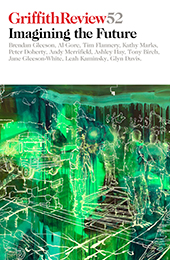Featured in

- Published 20160503
- ISBN: 978-1-925240-81-8
- Extent: 264pp
- Paperback (234 x 153mm), eBook

Already a subscriber? Sign in here
If you are an educator or student wishing to access content for study purposes please contact us at griffithreview@griffith.edu.au
Share article
About the author

Tim Flannery
Tim Flannery is a professor at the Melbourne Sustainable Society Institute, University of Melbourne. He has published over 140 peer-reviewed scientific papers and has...
More from this edition

De-Nazification and Blake’s illustration to Purgatory canto 9 (lines 64-101)
PoetrySnow is falling white-outover the Schloss and its collectionsof the dead. A small marble hand glistens in its case and holdsa...broken staff of life? In...

To a new Babylon
EssayIN THE WESTERN tradition, faith and reason stand at opposing poles. My social-scientific training was deeply framed by this polarity. A recent experience, however,...

Time travel
IntroductionTHE ABILITY TO travel through time in our minds, to inhabit re-created pasts and imagined futures, is arguably one of the defining characteristics of...